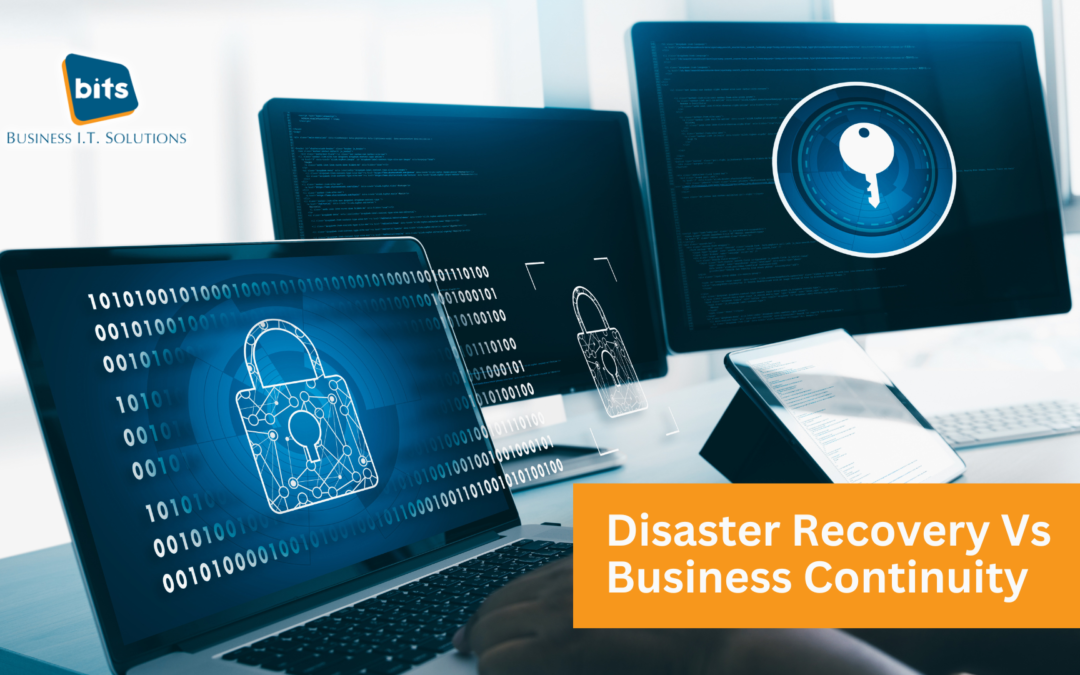Understanding the distinctions between disaster recovery (DR) and business continuity (BC) is crucial. Although often used interchangeably, these two strategies have unique focuses and goals. This article delves into the five principal distinctions between Disaster Recovery (DR) and Business Continuity (BC), shedding light on their unique contributions to bolstering organisational resilience. Understanding these differences enables companies to devise more precise strategies to counteract interruptions, whether they arise from unpredictable catastrophes or everyday business hurdles. Explore further below.
Disaster Recovery Plan:
A disaster recovery plan is an extensive strategy devised to restore an organisation’s IT infrastructure and operations following a significant disruptive event. It outlines procedures, roles, and responsibilities for recovering critical systems, applications, and data. The plan encompasses measures for data backup, restoration, and testing, ensuring minimal data loss and downtime. Its objective is to facilitate a prompt return to normal operations, protecting against various disasters such as cyberattacks and hardware failures. BITS disaster recovery services aid in mitigating business risks, maintaining customer trust, and ensuring continuity amidst unforeseen challenges.
Business Continuity Plan:
Conversely, a business continuity plan is a strategic framework outlining procedures and protocols to sustain essential business functions and operations during and after disruptive incidents. It addresses various scenarios, including natural disasters, technology failures, and other emergencies. The plan identifies key personnel, roles, and responsibilities, establishes communication channels, and details steps for relocating operations if necessary. By ensuring the availability of resources, data, and processes, a business continuity plan aims to minimise downtime, reduce financial losses, and uphold customer trust. It represents a proactive approach to risk management, enabling organisations to adapt swiftly and maintain functionality in adverse circumstances.
Differences between Business Continuity and Disaster Recovery:
While these terms are frequently used interchangeably, significant differences exist between business continuity and disaster recovery:
- Focus and Scope: BC encompasses all business operations, ensuring overall functionality during and after disruptions, while DR concentrates on restoring IT systems and data.
- Timeframe: BC involves strategies for sustained operations over extended periods, while DR prioritises rapid recovery to resume normal IT functions.
- Components: BC includes crisis communication, safety measures, customer relations, and alternative approaches, whereas DR involves data backup, restoration, failover systems, and IT resilience.
- Stakeholders: BC engages business units, management, employees, and partners, while DR predominantly involves IT teams and professionals.
- Incident Types: BC addresses various disruptions, from operational to cyber incidents, but DR mainly targets IT disruptions like hardware failures, cyberattacks, and data breaches.
Importance of Business Continuity and Disaster Recovery:
Business continuity and disaster recovery are vital for ensuring organisational survival and stability. BC plans sustain essential operations during disruptions, safeguarding revenue, customer trust, and brand image. Similarly, disaster recovery strategies swiftly restore critical IT systems after incidents, minimising downtime and data loss, thereby preserving productivity and service delivery. These practices collectively enhance an organisation’s ability to navigate unforeseen events, be it natural disasters or cyberattacks, minimising financial losses and operational setbacks. Ultimately, they ensure the organisation’s resilience, aiding in adaptation and rebounding from challenges while maintaining business continuity and minimising adverse impacts on stakeholders.
Do You Need Both?
Yes, both business continuity and disaster recovery are indispensable components of a comprehensive resilience strategy for any organisation. Although they have distinct focuses, they complement each other to provide a well-rounded approach to mitigating the impacts of disruptions. While a business continuity plan ensures that all aspects of the business continue to operate during and after disruptions, a disaster recovery plan kicks into action in the event of detrimental occurrences affecting IT infrastructure. Together, these strategies equip an organisation to handle a wide range of disruptions, from minor incidents to major disasters, enabling it to resume normal operations as quickly as possible while minimising adverse impacts.
BITS provide a combined solution for our clients around Business Continuity and Disaster Recovery that empowers businesses to establish robust strategies, ensuring resilience and seamless operations even in the face of IT adversity. Contact us today to discover more about implementing these strategies, we are happy to work with you to develop a comprehensive strategy around BCDR for your business.


